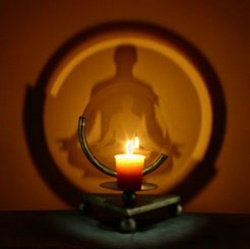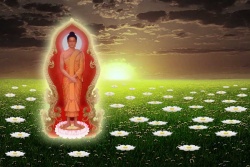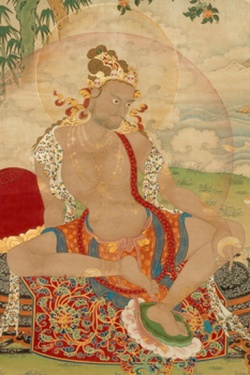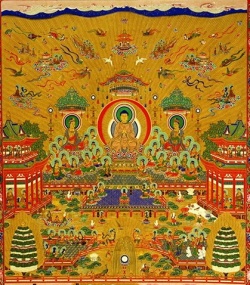The verity of myth
THE study of the hidden meaning in every religious and profane legend, of whatsoever nation, large or small -- but eminently the traditions of the East -- occupied the greater portion of the life of H. P. Blavatsky. She felt convinced from such study that no mythological story, no traditional event in the folk-lore of a people has ever been, at any time, pure fiction; but that every one of such narratives has an actual, historical lining to it. The fables of mythology, she believed, were the means of conveying facts; they were neither forgeries nor fictions. "When the false theologies disappear, then true prehistoric realities will be found, contained especially in the mythology of the Aryans -- the ancient Hindus and even the pre-Homeric Hellenes."
H. P. Blavatsky wrote that the origin and meaning of mythology have been missed altogether. Mythology was a primitive mode of thinking. It was founded on natural facts, and is still verifiable in phenomena. There is nothing insane, nothing irrational in it, when considered in the light of evolution, and when its mode of expression by sign language is thoroughly understood. Mythology is the repository of man's most ancient science, and what concerns us chiefly is this -- when truly interpreted once more, it is destined to be the death of those false theologies to which it has unwittingly given birth. Judaism, earlier and later Gnosticism, Christianity, and even Christian Masonry have all been erected upon identical cosmical myths, symbols and allegories, whose full comprehension is possible only to those who have inherited the key from their inventors. To show how much these have been misinterpreted by the widely different, yet intimately related systems, in fitting them to their individual needs, is not only to confer a benefit upon the student but as well to do a long deferred and much needed act of justice to those earlier generations, whose genius has laid the whole human race under obligation.
Myth was the favorite and universal method of teaching in archaic times, and in the use of allegory the truth was left to be deduced. Those myths which have now reached us and are rejected as absurd fables are often the fragments of old systems. Yet no one can seriously study ancient philosophies, in whatever form portrayed, without perceiving that the striking similitude of conception between all -- in their exoteric form very often, in their hidden spirit invariably -- is the result of no mere coincidence but of a concurrent design. And that there was, during the youth of mankind, one language, one knowledge, one universal religion, when there were no churches, no creeds or sects, but when every man was a priest unto himself. And if it is shown that already in those ages which are shut out from our sight by the exuberant growth of tradition, human religious thought developed in uniform sympathy in every portion of the globe; then it becomes evident that, born under whatever latitude, in the cold North or the burning South, in the East or West, that thought was inspired by the same revelations, and man was nurtured under the protecting shadow of the same Tree of Knowledge.
If error has prevailed and superstition run riot these many centuries throughout Christendom, it is the misfortune of the common people, the reproach of science. Each age had its unbelieving Thomases. But have they ever succeeded in checking the progress of truth? No more than the ignorant bigots who sat in judgment over Galileo checked the progress of the earth's rotation. No "exposures" whatever are able to vitally affect the stability or instability of a belief which humanity inherited from the first races of men, those who -- if we can believe in the evolution of the spiritual man as in that of the physical one -- had the great truth from the lips of their ancestors, the gods of their fathers, "that were on the other side of the flood." The identity of the Bible with the legends of the Hindu sacred books and the cosmogonies of other nations, must be demonstrated at some future day. Fables of the mythopoeic age will be found to have but allegorized the greatest truths -- even of geology and anthropology. It is in these ridiculously expressed fables, too, that science will have to look for her "missing links." For all possess a common identity of primitive conceptions, which -- fables and legends though they are termed now and however thickly overgrown with the husks of popular embellishment -- contain nevertheless the kernel of scientific and historical facts, and are still truths.
In nearly every mythology, which after all is ancient history, giants as well as the first couple play an important part. It will always be a subject of regret that history, rejecting a priori the actual existence of giants, has preserved us so little of the records of antiquity concerning them. Compare only this verse of Genesis vi: "And it came to pass, when men began to multiply on the face of the earth, and daughters were born unto them, that the sons of god saw the daughters of men that they were fair; and they took them wives of all which they chose.... There were giants in the earth in those days," etc. -- with the part of the Hindu cosmogony in the Vedas, which speaks of the descent of the Brahmans and of the first Brahman complaining of being alone among all his brethren without a wife. Notwithstanding that the Eternal advises him to devote his days solely to the study of the Sacred Knowledge (Vidya), the first-born of mankind insists. Provoked at such ingratitude, the Eternal gives Brahman a wife of the race of giants, from whom all the Brahmans maternally descend. The same is found in the Scandinavian cosmogonical fragment, in the Edda, which shows the first man, called Bur, "the father of Bor, who took for wife Besla, a daughter of the giant Boltharam of the race of the primitive giants." The same groundwork underlies the Grecian fables about the Titans; and may be found in the legend of the Mexicans -- the four successive races of the Popul-Vuh. It constitutes one of the many ends to be found in the entangled and seemingly inextricable skein of mankind, viewed as a psychological phenomenon.
In Cornwall and in ancient Britain the traditions of giants are excessively common, and they are said to have lived even down to the time of King Arthur. All this shows that giants lived to a later date amongst the Celtic than among the Teutonic peoples. It would be poor anthropology indeed that would restrict the traditions of giants to Greek and Bible mythologies. Slavonian countries, Russia especially, teem with legends about the bogatery (mighty giants) of old; and their folk-lore, most of which has served for the foundation of national histories, their oldest songs, and their most archaic traditions, speak of giants of old. Giants were real living men, whether twenty or twelve feet high. In the old Norse mythology the giants, Skrymir and his brethren, against whom the sons of the gods fought, were potent factors in the histories of deities and men. Even the Homeric heroes, who of course belonged to a far more recent period in the history of the races, appear to have wielded weapons of a size and weight beyond the strength of the strongest men of modern times. If we turn to the New World, we have traditions of a race of giants at Tarija on the eastern slope of the Andes and in Ecuador, who combated the gods and men. These old beliefs, which term certain localities los compos de los gigantes, "the fields of the giants," still persist in tradition.
We venture to say that the language of the Initiated few -- as in the veiled writings of Plato -- was far more plain, and their science-philosophy far more comprehensive and satisfying alike to the physical and spiritual wants of man, than the terminology and systems respectively elaborated by modern sages. The so-called myths, in order to be at least approximately dealt with in any degree of justice, have to be closely examined from all their aspects. There are seven Keys to these ancient truths about man and his world about him, each of which has to be used in its right place and never mixed with any of the others. In our day of dreary soul-killing materialism, happily now beginning its ebb-tide, the ancient priest-Initiates have become in the opinion of our learned generations the synonyms of clever impostors, kindling the fires of superstition in order to obtain an easier sway over the minds of men. "Realism, not myth," is the demand of the hour. It is an unfounded calumny, generated by skepticism and uncharitable thoughts. No one believed more in Gods -- or, we may call them, the Spiritual and now invisible Powers, the noumena of the phenomena -- than they did. If, initiated into the Mysteries of Nature, and just because they knew, they were forced to withhold their knowledge from the profane, who would have sorely abused it, such secrecy was undeniably less dangerous than the policy of their usurpers and successors. The former taught only that which they knew. The latter, teaching that which they did not know, have invented, as a secure haven for their ignorance, a jealous and cruel Deity, who forbids man to pry into his mysteries under the penalty of damnation. And well they may, for his mysteries can at best be only hinted at in polite ears, never described. "It is not the key of St. Peter, or the Church dogma, but the narthex -- the wand of the candidate for initiation -- that has to be wrenched from the grasp of the long silent Sphinx of the ages."
The one prevailing, most distinct idea found in all ancient teaching with reference to cosmic evolution and the first "creation" of our globe with all its products -- is that the whole Kosmos has sprung from the DIVINE THOUGHT. This thought impregnates matter, which is co-eternal with the One Reality; and all that lives and breathes evolves from the emanations of the One immutable, eternal root. These successive emanations are the "gods" of all the myths. And in every folk-lore the idea of the (emanated) "Creator" was symbolized generally by the Dragon and the Serpent -- the Dragon of Good and the Serpent of Evil. These represent the gods and the demons, on earth the right- and the left-hand Magic. The great "Wars in Heaven" between the opposing forces found in the Puranas; the wars of the Titans in Hesiod and other classical writers; the "struggles" also in the Egyptian legend between Osiris and Typhon, and even those in the Scandinavian legends, all refer to the same subject. Northern mythology refers to it as the battle of the Flames, the sons of Muspel who fought on the field of Wigred. All these relate to Heaven and Earth, and have a double and often even a triple meaning, and esoteric application to things above as to things below. They relate severally to astronomical, theogonical, and human struggles; to the adjustment of orbs, and the supremacy among nations and tribes. There are few myths in any religious system worthy of the name but have, as said, an historical as well as a scientific foundation. The "Struggle for Existence" and the "Survival of the Fittest" reigned supreme from the moment that Kosmos manifested into being, and could hardly escape the observant eye of the ancient sages. Hence the incessant fights of Indra, the god of the Firmament, with the Asuras; the battles fought between stars and constellations, between Moon and planets -- later on incarnated as kings and mortals. Hence also the War in Heaven of Michael and his Host against the Dragon (Jupiter and Venus-Lucifer), when a third of the stars of the rebellious host was hurled down into Space, and "its place was found no more in heaven."
Archaic astronomy and the ancient physical and mathematical sciences expressed views identical with those of modern science, and many of far more numerous import. A struggle for life and a survival of the fittest in the worlds above, as on our planet here below, are distinctly taught. In Hindu mythology the celebrated War in Heaven or the prototypal battles between the gods, refers to several events on various and different planes of being. One of the meanings of the allegory of Brihaspati (Jupiter) is given as follows: Brihaspati is the presiding genius or regent of the planet Jupiter, the "guru of the gods." In the allegory he is the wronged husband, and "represented the dead-letter form of worship." It is Tara his wife -- the symbol of one who, though wedded to dogmatic worship, longs for true wisdom -- who is shown as initiated into his mysteries by King Soma, the giver of that wisdom. Soma the (male) Moon, Paris-like, carries this new Helen of the Hindu sidereal Kingdom away from her husband, which causes a great strife and war in Swarga (heaven). The episode brings on a great battle between the gods and the Asuras; both sides finding allies in the prototypes of those who later become the Titans of various nations and the Miltonian Michaels and "leaders and members of the celestial Hosts." Soma is thus made in the allegory to carry her away. The result of this is the birth of Buddha -- esoteric Wisdom -- (Mercury or Hermes in Greece and Egypt). The latter is represented as "so beautiful," that even the husband, though well aware that Budha is not the progeny of his dead-letter worship -- claims the "new-born" as his Son, the fruit of ritualistic and meaningless forms. It is not hard to see the same story in the modern exoteric religions.
The imagination of the ancients proved as boundless as the visible manifestations of the Deity itself which afforded them the themes for their allegories. Two things must be born in mind with regard to those myths with which we are in closest affinity: (a) the ancients allegorized the most important as well as the most trifling causes of the celestial motions; the nature of every phenomenon was personified; and in the mythical biographies of the Olympic gods and goddesses, one well acquainted with the latest principles of physics and chemistry can find their causes, inter-agencies, and mutual relations embodied in the deportment and course of action of the fickle deities; (b) that before the time when the Olympian Jupiter (the Hindu Brihaspati) was anthropomorphized by the genius of Phidias into the Omnipotent God, the Maximus, the God of gods, and thus abandoned to the adoration of the multitudes -- in the earliest and abstruse science of symbology he embodied in his person and attributes the whole of the cosmic forces. In the Orphic theology, the oldest of all, metaphysically speaking, he represented both the potentia and actus -- the unrevealed cause and the Demiurge, or the active creator as an emanation from the invisible potency. "Zeus" (Jupiter), says an Orphic hymn, "is the first and the last, the head and the extremities. From him have proceeded all things. He is a man and an immortal nymph (male and female element); the soul of things; and the principle motor in fire. He is the sun and moon, the fountain of the ocean, the demiurgos of the universe; one power, one God, the mighty creator and governor of the cosmos. Everything, fire, water, earth, ether, night, the heavens; Metis, the primeval architecturess (the Sophia of the Gnostics and the Sephira of the Kabalists), the beautiful Eros, Cupid, all is included within the vast dimensions of his glorious body."
The metaphysical researches of those ancients never clashed with scientific truths. And their religions may be truly termed the psycho-physiological creeds of the priests and scientists, who built them on the traditions of the infant-world -- traditions as received by the unsophisticated minds of the primitive races -- and on their own experimental knowledge, hoary with all the wisdom of the intervening ages. There is hardly a scientific law, whether pertaining to physical astronomy or physical geography that could not be easily pointed out in the ingenious combinations of their fables. "We have, for example, but to open the most common book on astrology, and compare the descriptions embraced in the Fable of the Twelve Houses with the most modern discoveries of science as to the nature of the planets and the elements in each star, to see that without any spectroscope the ancients were perfectly well acquainted with the same. There we can learn to a certain extent of the degree of solar heat, light, and nature of the planets by simply studying their symbolic representations in the Olympic gods, and the twelve signs of the Zodiac, to each of which in astrology is attributed a particular quality...."
The stumbling-block of scientific research into the world of the myth arises from a want of the sagacity called for to penetrate its substructure. Because of this, legends, allegories, symbols, if they but belong to the Hindu, Chaldean, or Egyptian tradition are thrown into the same heap of fiction. Plato declares in the Gorgias and the Phaedo that myths are the vehicles of great truths well worth the seeking. Voltaire, after forty years of comparing and combining the systems of Plato, Aristotle, Pythagoras, and the Oriental, voices the conviction: "Chance is a word void of sense. The world is arranged according to mathematical laws." The doctrine of the Ages asserts the presence of a logos (spirit of Truth) within every mythos. This is the first key to be adopted and used.
The Wisdom-Religion explains simply enough the nature of its child, the Myth, and the difficulty encountered in comprehending it. For one unacquainted with the esoteric explanation of the doctrines of those ancients, the path is hard, the outlook difficult to determine. Yet from knowledge, not ignorance, sprang the myths. Only when they are pondered deeply enough will their concealed wisdom make its appearance.







